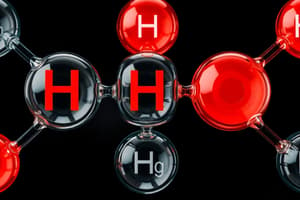Podcast
Questions and Answers
What does Hund's rule state about electron occupancy in degenerate orbitals?
What does Hund's rule state about electron occupancy in degenerate orbitals?
Which of the following describes a covalent bond?
Which of the following describes a covalent bond?
What type of bond results from the electrostatic attraction between oppositely charged ions?
What type of bond results from the electrostatic attraction between oppositely charged ions?
In terms of stability, what condition did G.N. Lewis propose for atoms?
In terms of stability, what condition did G.N. Lewis propose for atoms?
Signup and view all the answers
What phenomenon describes the tendency of an atom to attract bonding electrons toward itself?
What phenomenon describes the tendency of an atom to attract bonding electrons toward itself?
Signup and view all the answers
What percentage of the final assessment does the written exam contribute?
What percentage of the final assessment does the written exam contribute?
Signup and view all the answers
What defines an isotope?
What defines an isotope?
Signup and view all the answers
How many orbitals does the first shell of an atom consist of?
How many orbitals does the first shell of an atom consist of?
Signup and view all the answers
What is the main focus of organic chemistry?
What is the main focus of organic chemistry?
Signup and view all the answers
According to the Pauli exclusion principle, how many electrons can occupy a single atomic orbital?
According to the Pauli exclusion principle, how many electrons can occupy a single atomic orbital?
Signup and view all the answers
Study Notes
Introduction
- Course taught by Alaa Arafat Hayallah
Assessment Weighting
- Written exam: 50%
- Midterm exam: 15%
- Practical exam: 25%
- Oral exam: 10%
- Total: 100%
Main Topics
- Introduction to Organic Chemistry
- Aliphatic Hydrocarbons (Alkanes, Alkenes, Alkynes, and Alkyl Halides)
- Stereochemistry
- Aromatic Compounds
- Recommended textbook: Organic Chemistry (by Graham Solomons)
Organic Chemistry Definition
- A chemistry subdiscipline studying the structure, properties, and reactions of organic compounds and materials (matter containing carbon atoms).
- Methods include spectroscopy (IR, NMR), mass spectrometry, and other physical/chemical methods to determine composition and constitution.
- Study of properties includes both physical and chemical properties, and methods to evaluate chemical reactivity to understand organic matter's behavior.
Structure of the Atom
- Atomic number = number of protons in the nucleus.
- Mass number = sum of protons and neutrons.
- Isotopes have the same atomic number but different mass numbers due to differing neutron counts.
Electron Distribution
- Electrons occupy concentric shells around the nucleus.
- First shell closest, subsequent shells further out.
- Each shell has subshells (atomic orbitals).
- Closer orbitals to nucleus have lower energy.
Filling Orbitals
- Pauli exclusion principle: A maximum of two electrons can occupy an orbital and they must have opposite spins.
- Hund's rule: In degenerate orbitals (same energy), electrons first occupy empty orbitals before pairing up. This minimizes electron repulsion.
Atomic Orbitals
- Orbitals are three-dimensional regions around the nucleus where electrons are likely to be found.
- Different types of atomic orbitals exist
- s orbitals are spherical in shape
- p orbitals have a dumbbell shape and occur in sets of three (px, py, pz)
Electronic Distributions (Table)
- A table displaying the electronic distributions for various elements. (Elements and their respective electronic configurations for 1s, 2s, and 2p orbitals)
Chemical Bonding: Ionic Bonding
- G.N. Lewis proposed that atoms attain stability when their outermost shell is filled (or contains 8 electrons).
- Ionic bond: formed by electron transfer.
- The atom losing electrons forms a positive ion (cation).
- The atom gaining electrons forms a negative ion (anion).
- The bond results from electrostatic attraction between these oppositely charged ions.
Chemical Bonding: Covalent Bonding
- Covalent bond: Atoms share valence electrons to attain noble gas configurations.
- Examples: Hydrogen (H2), Chlorine(Cl2), and Methane (CH4)
Chemical Bonding: Polar Covalent Bonding
- Polar covalent bond: When two atoms with different electronegativities form a covalent bond.
- Electrons are not shared equally.
- The atom with higher electronegativity pulls the electrons closer, creating a partial negative charge (δ-)
- The other atom experiences a partial positive charge (δ+).
- Electronegativity is the tendency of an atom to attract bonding electrons. Higher electron density around higher electronegativity atoms creates polarity.
Studying That Suits You
Use AI to generate personalized quizzes and flashcards to suit your learning preferences.
Related Documents
Description
Test your knowledge on the basics of Organic Chemistry with this quiz. Explore topics such as aliphatic hydrocarbons, stereochemistry, and aromatic compounds, along with methods of analysis. This assessment is based on the recommended textbook by Graham Solomons.




